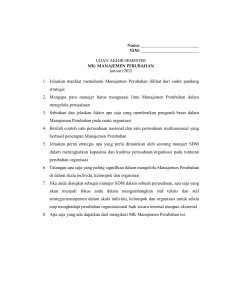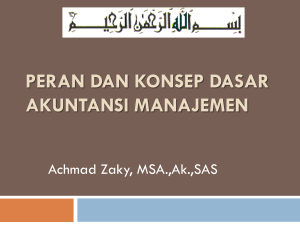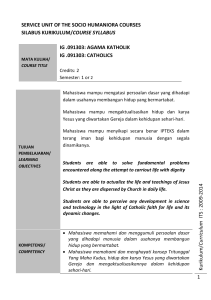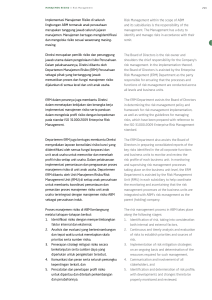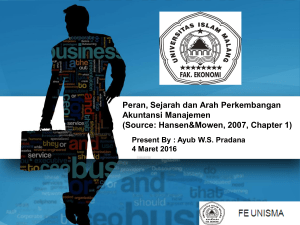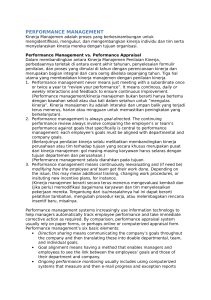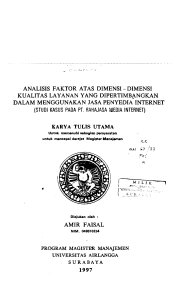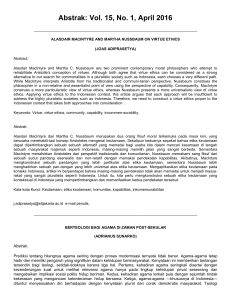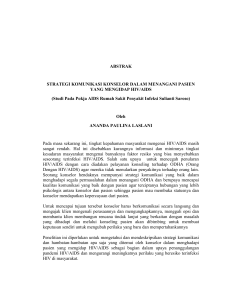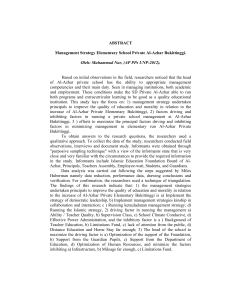Phase 4: Strategic management
advertisement
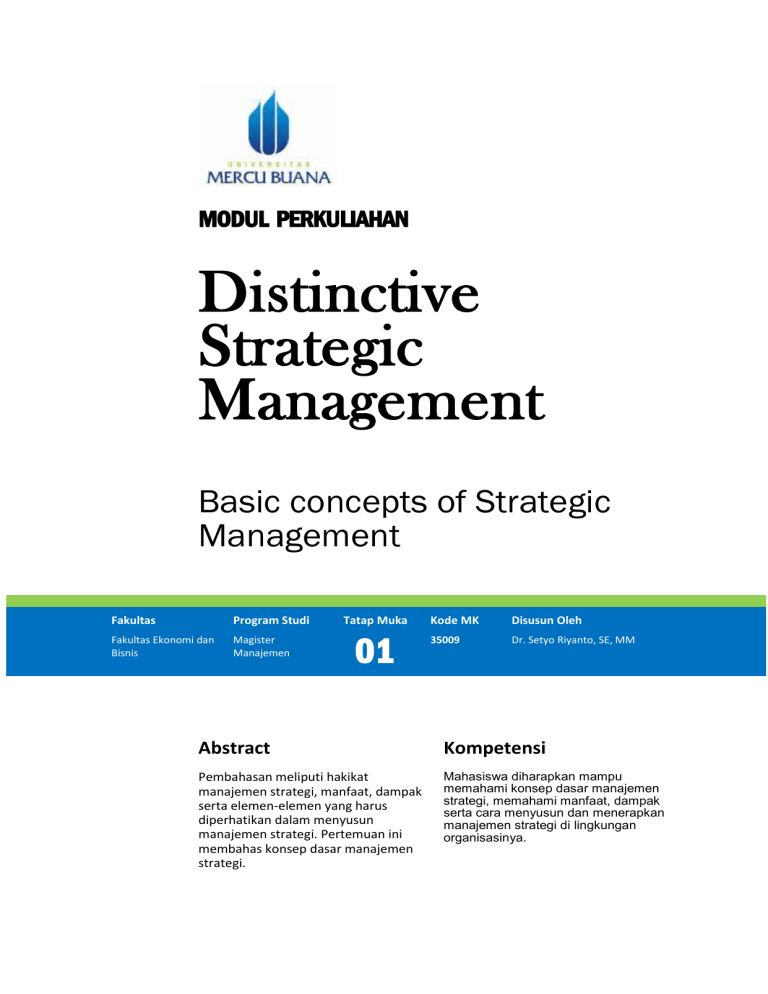
MODUL PERKULIAHAN Distinctive Strategic Management Basic concepts of Strategic Management Fakultas Program Studi Fakultas Ekonomi dan Bisnis Magister Manajemen Tatap Muka 01 Kode MK Disusun Oleh 35009 Dr. Setyo Riyanto, SE, MM Abstract Kompetensi Pembahasan meliputi hakikat manajemen strategi, manfaat, dampak serta elemen-elemen yang harus diperhatikan dalam menyusun manajemen strategi. Pertemuan ini membahas konsep dasar manajemen strategi. Mahasiswa diharapkan mampu memahami konsep dasar manajemen strategi, memahami manfaat, dampak serta cara menyusun dan menerapkan manajemen strategi di lingkungan organisasinya. A. Why Strategic Management? Dewasa ini, ketika persaingan usaha telah menjadi hal yang lumrah dan bersifat lintas batas, hal yang tidak lagi dapat dihindari adalah bagaimana tetap membuat suatu entitas bisnis eksis. Hal inilah yang menyebabkan mengapa manajemen perlu mempelajari manajemen stratejik. Hal mendasar terkait dengan suatu pilihan strategi atas organisasi adalah mengetahui dengan baik, dimanakah organisasi saat ini? dimana perusahaan atau organisasi akan berada dalam satu tahun ke depan; dua tahun; lima tahun; sepuluh tahun? Apakah jawabannyasesuai dengan harapan dan kehendak kita? Dalam konteks inilah, manajemen strategis sebagaimana dinyatakan oleh Wheelen (2012) diharapkan mampu memberikan manfaat setidaknya pada 8 (delapan) hal sbb: 1. Clearer sense of strategic vision for the firm 2. Sharper focus on what is strategically important 3. Improved understanding of a rapidly changing environment 4. Improved organizational performance 5. Achieves a match between the organization’s environment and its strategy, structure and processes 6. Important in unstable environments 7. Strategic thinking 8. Organizational learning Fred R David (2011) memiliki pendapat yang hampir sama, dimana Fred menyatakan setidaknya ada 11 kemanfaatan manajemen stratejik bagi organisasi, meliputi: 1. It allows for identification, prioritization, and exploitation of opportunities. 2. It provides an objective view of management problems. 3. It represents a framework for improved coordination and control of activities. 4. It minimizes the effects of adverse conditions and changes. 5. It allows major decisions to better support established objectives. 6. It allows more effective allocation of time and resources to identified opportunities. 7. It allows fewer resources and less time to be devoted to correcting erroneous or ad hoc 2015 2 Distinctive Strategic Management Dr. Setyo Riyanto, SE, MM Pusat Bahan Ajar dan eLearning http://www.mercubuana.ac.id decisions. 8. It creates a framework for internal communication among personnel. 9. It helps integrate the behavior of individuals into a total effort. 10. It provides a basis for clarifying individual responsibilities. 11. It encourages forward thinking. 12. It provides a cooperative, integrated, and enthusiastic approach to tackling problems and opportunities. 13. It encourages a favorable attitude toward change. 14. It gives a degree of discipline and formality to the management of a business B. What is Strategic Management? Menurut Wheelen dan Hunger (2012), manajemen stratejik adalah serangkaian keputusan dan tindakan manajerial yang menentukan kinerja perusahaan dalam jangka panjang. Manajemen strategis adalah suatu cara pengelolaan organisasi atau program yang dilakukan dengan memperhatikan lingkungan eksternal dan lingkungan internal dari organisasi atau program tersebut. Mencakup ke dalam aktivitas dalam manajemen stratejik ini antara lain adalah bagaimana strategi di formulasikan, bagaimana strategi di implementasikan serta tidak kalah penting adalah, bagaimana strategi tadi di kendalikan dan di evaluasi pelaksanaannya. Fred R David (2011) bahkan menyebutnya sebagai seni dan ilmu dalam memformulasikan, mengimplementasikan serta mengevaluasi keputusan-keputusan lintas fungsi guna mencapai tujuan yang hendak dicapai. Adapun fase-fase di dalam manajemen stratejik meliputi : Phase 1: Basic financial planning Phase 2: Forecast-based planning Phase 3: Externally oriented strategic planning Phase 4: Strategic management Nampak dari fase tersebut di atas, bahwa manajemen stratejik merupakan fase terakhir yang dilakukan, setelah permasalahan perencanaan keuangan, teknik penduga yang dipilih serta orientasi eksternal organisasi dengan baik didefinisikan. 2015 3 Distinctive Strategic Management Dr. Setyo Riyanto, SE, MM Pusat Bahan Ajar dan eLearning http://www.mercubuana.ac.id Walau banyak ahli mengutarakan betapa luar biasa pentingnya penerapan manajemen stratejik bagi suatu organisasi, namun tidak sedikit perusahaan yang enggan melakukan dan menerapkan manajemen stratejik. Hal ini, masih menurut Fred lebih disebabkan oleh: 1. Lack of knowledge or experience in strategic planning—No training in strategic planning. 2. Poor reward structures—When an organization assumes success, it often fails to reward success. When failure occurs, then the firm may punish. 3. Firefighting—An organization can be so deeply embroiled in resolving crises and firefighting that it reserves no time for planning. 4. Waste of time—Some firms see planning as a waste of time because no marketable product is produced. Time spent on planning is an investment. 5. Too expensive—Some organizations see planning as too expensive in time and money. 6. Laziness—People may not want to put forth the effort needed to formulate a plan. Content with success—Particularly if a firm is successful, individuals may feel there is no need to plan because things are fine as they stand. But success today does not guarantee success tomorrow. 7. Fear of failure—By not taking action, there is little risk of failure unless a problem is urgent and pressing. Whenever something worthwhile is attempted, there is some risk of failure. 8. Overconfidence—As managers amass experience, they may rely less on formalized planning. Rarely, however, is this appropriate. Being overconfident or overestimating experience can bring demise. Forethought is rarely wasted and is often the mark of professionalism. 9. Prior bad experience—People may have had a previous bad experience with planning, that is, cases in which plans have been long, cumbersome, impractical, or inflexible. Planning, like anything else, can be done badly. 10. Self-interest—When someone has achieved status, privilege, or self-esteem through effectively using an old system, he or she often sees a new plan as a threat. 11. Fear of the unknown—People may be uncertain of their abilities to learn new skills, of their aptitude with new systems, or of their ability to take on new roles. 12. Honest difference of opinion—People may sincerely believe the plan is wrong. They may view the situation from a different viewpoint, or they may have aspirations for 2015 4 Distinctive Strategic Management Dr. Setyo Riyanto, SE, MM Pusat Bahan Ajar dan eLearning http://www.mercubuana.ac.id themselves or the organization that are different from the plan. Different people in different jobs have different perceptions of a situation. 13. Suspicion—Employees may not trust management. C. How Strategic Management? Dalam menerapkan manajemen stratejik di organisasi, setidaknya terdapat empat elemen mendasar yang harus menjadi fokus manajemen, masing-masing pada tahapan: a. Environmental scanning b. Strategy formulation c. Strategy implementation d. Evaluation and control Beberapa guidelines dalam menyusun suatu rencana strategis perusahaan agar diperoleh hasil yang baik, al disampaikan oleh Wheelen (2012), sbb: 1. It should be a people process more than a paper process. 2. It should be a learning process for all managers and employees. 3. It should be words supported by numbers rather than numbers supported by words. 4. It should be simple and non routine. 5. It should vary assignments, team memberships, meeting formats, and even the planning calendar. 6. It should challenge the assumptions underlying the current corporate strategy. 7. It should welcome bad news. 8. It should welcome open-mindness and a spirit of inquiry and learning. 9. It should not be a bureaucratic mechanism. 10. It should not become ritualistic, stilted, or orchestrated. 11. It should not be too formal, predictable, or rigid. 12. It should not contain jargon or arcane planning language. 13. It should not be a formal system for control. 2015 5 Distinctive Strategic Management Dr. Setyo Riyanto, SE, MM Pusat Bahan Ajar dan eLearning http://www.mercubuana.ac.id 14. It should not disregard qualitative information. 15. It should not be controlled by “technicians.” 16. Do not pursue too many strategies at once. 17. Continually strengthen the “good ethics is good business” policy. 2015 6 Distinctive Strategic Management Dr. Setyo Riyanto, SE, MM Pusat Bahan Ajar dan eLearning http://www.mercubuana.ac.id Daftar Pustaka 1. Wheelen TL, J David Hunger, 2012, Strategic Management and Business Policy th toward Global Sustainability, 13 ed, Pearson. th 2. David R. Fred, 2011, Strategic Management Concepts and Cases, 13 edition, Prentice Hall. 3. Hitt, Ireland, Hoskisson, 2011, Strategic Management Competitiveness and th Globalization, 9 edition, South-Western Cengage Learning. 2015 7 Distinctive Strategic Management Dr. Setyo Riyanto, SE, MM Pusat Bahan Ajar dan eLearning http://www.mercubuana.ac.id
